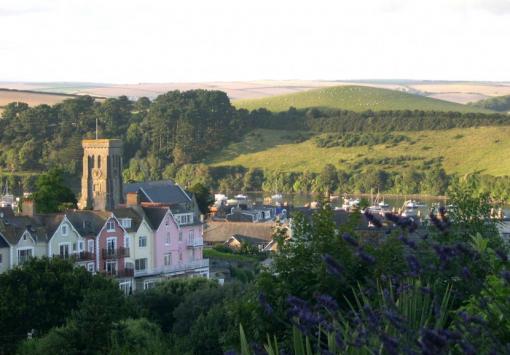 Salcombe
Salcombe
Salcombe became famous for the schooners which brought fruit from the West Indies. Details of this past trade and other local history can be found in the Museum of Maritime and Local History on the Custom House Quay. The museum has a fascinating collection illustrating ship building and ship wrecks, in addition to maps and information about local training areas during World War Two.
These days the town is a retirement haven, to some extent because it enjoys some of the mildest weather in England. Gardens are terraced down to the edge of the water and contain such exotic plants as palms and orange and lemon trees. The latter have even been known to bear fruit.Salcombe is also a centre for pleasure craft and ferries. Sailing and motor boats are available for hire with or without tuition. Travelling the estuary by ferry is one of the nicest ways to get around. The Rivermaid Ferry sails to Kingsbridge and the East Portlemouth Ferry crosses the estuary to the lovely, sheltered beaches of Smalls Cove, Mill Bay and Sunny Cove. The third ferry goes to South Sands where various water sports can be enjoyed.
The Overbecks Museum with its exotic coastal garden, rare plant species and spectacular views is just past North Sands. The promontory here has the remains of one of the coastal defences built by Henry VIII.
Hope Cove is a walk of about six miles along the cliffs. This delightful village nestles within a small, enclosed, green valley, which slopes down to two pleasant sheltered beaches. The cove was originally a small fishing and crabbing village and remains remarkably unchanged today. Fishing from the rocks or from small boats is still enjoyed by many, although commercial fishing has long since ceased. In addition to various pubs and restaurants, there is plenty of accommodation here for the visitor. There are a couple of shops in the village and a lovely square of thatched cottages, unspoiled by development. Other picturesque cottages nestle between more modern buildings. St Clement’s Church overlooks the cove. This tiny place has an atmosphere evocative of its past.
The beaches are clean, sandy and safe. There are rock pools for children and water sports for the more adventurous. The unusually clear water attracts divers to explore the seabed the many shipwrecks in the area. Dolphins and seals can often be seen swimming and diving in the cove.
A short walk along the stunning South Devon Coastal Path towards Thurlestone Sands provides spectacular views of Bigbury Bay, Burgh Island, Thurlestone Rock and along the coast to Cornwall. In May 1588 thousands of people gathered on the great cliffs of Bolt Tail to watch the Spanish Armada sail up the Channel. One of the galleons went aground on the large rocky headland that divides Hope’s two beaches.
Thurlestone Sands is a wide sandy beach backed by a nature reserve where rare birds have often been spotted. This is another popular venue for water sports. Slightly inland is the village of Thurlestone named after the large holed sea rock famously painted by William Turner. 13th century Thurlestone Church was where the first beacon fire was lit when the Spanish Armada was sighted.
Walks along the Coastal Path, through picturesque villages or on Dartmoor are all possible from Salcombe. The South West Coastal Path passes through the resort. Salcombe Estuary is a site of Special Scientific Interest and, particularly in spring and autumn, the sand and mud flats of the estuary are filled with birds.
There are plenty of cafés, restaurants and galleries in Salcombe and many of the eating places serve locally caught fish and shellfish. Popular local events include Dragon Boat Race Day, Regatta Week, and the Salcombe Festival, an event with musical talent and a variety of other street entertainers. Of course Salcombe is famous for boats and these are here in all shapes and sizes. Sometimes they can be an entertainment in themselves: They have a habit of tipping their crews out on occasions - to the delight of the onlookers.
